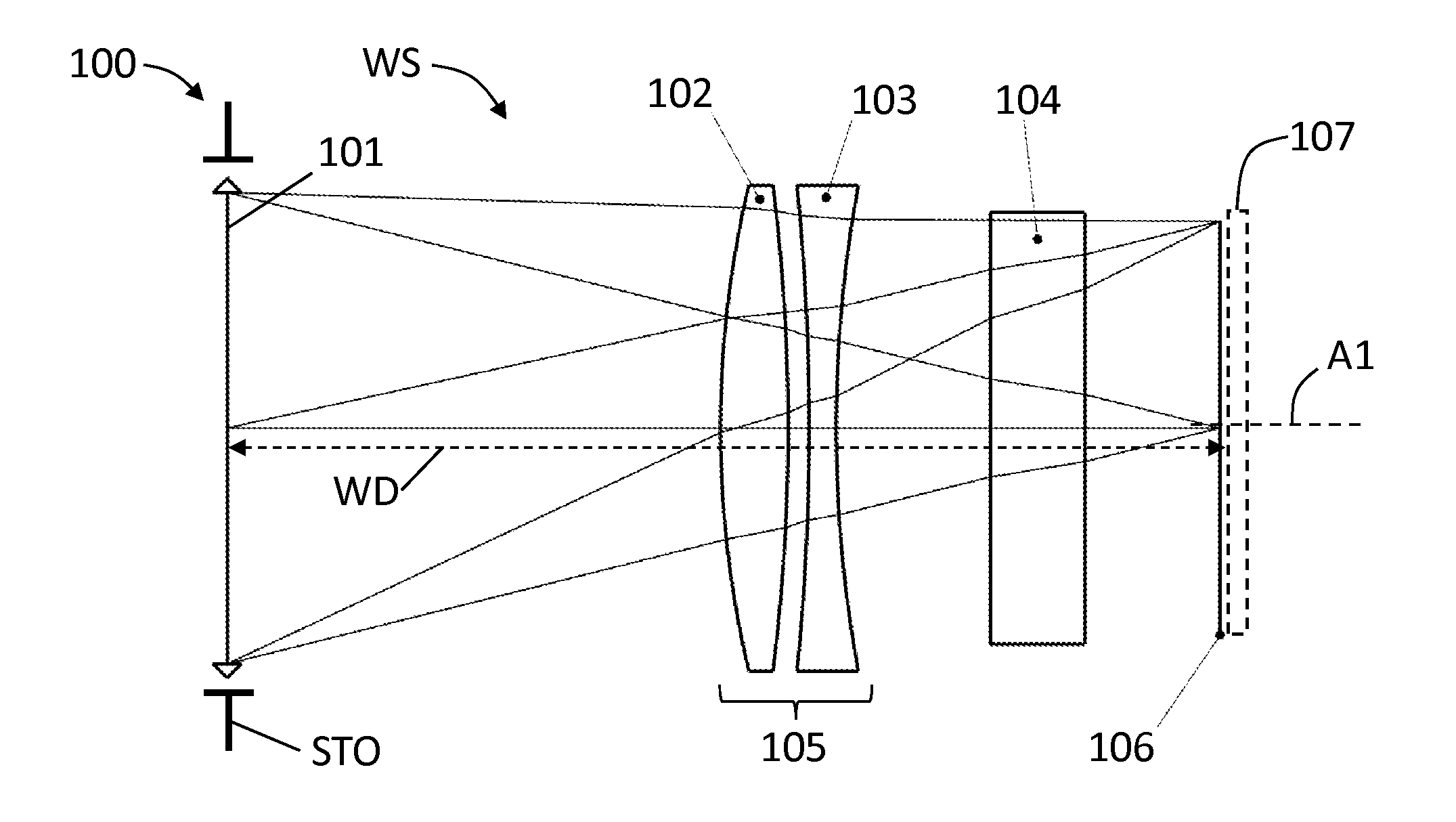Corrective optical systems and methods
- Summary
- Abstract
- Description
- Claims
- Application Information
AI Technical Summary
Benefits of technology
Problems solved by technology
Method used
Image
Examples
example 1
Corrector Example 1
[0071]FIG. 1 is an optical diagram of an imaging optical system 100 that includes, along an axis A1, a perfect or ideal objective (“objective”) 101, a flat plate 104, and a first example (Example 1) corrective optical system (“corrector”) 105, which resides between the objective and the flat plate. Imaging optical system 100 has an image plane 106. Objective 100 has a working space WS between the objective 101 (more specifically, the rearmost lens element of the objective) and image plane 106. The working space WS has an associated working distance WD.
[0072]Corrector 105 is designed to be universal, which means that it can correct the aberrations introduced into a perfect objective 101 by flat plate 104. The perfect objective 101 is aberration-free only when it is used by itself, i.e., without any flat plates in the working space WS. Adding the flat plate 104 introduces a range of aberrations, including spherical aberration, coma, astigmatism, longitudinal chromat...
example 2
[0081]FIG. 3 shows a second example (Example 2) of imaging optical system 100, wherein corrector 105 is optimized for a large aperture (f / 1.4) and large image diagonal (43.26 mm). Corrector 105 of Example 2 is thus suitable for use with a full-frame 35 mm format (24 mm×36 mm) objective 101.
[0082]Corrector 105 of Example 2 is also designed as a universal corrector. Corrector 105 comprises, in order along axis A1 from objective 101 to image plane 106, a bi-convex positive powered lens element 102 and a bi-concave negative powered lens element 103.
[0083]To maximize the use of the available working space WS, corrector 105 has slightly negative optical power. This in turn requires that the positive element 102 be made from a material having a lower index of refraction than the negative element 103 to avoid introducing backward field curvature. As a result, the image plane 106 can be planar.
[0084]FIG. 4 shows two different plots of MTF vs. Image Height at a spatial frequency of 20 lp / mm. ...
example 3
[0087]FIG. 5 illustrates a third example (Example 3) of imaging optical system 100, wherein corrector 105 is designed as a custom corrector for a particular objective 101. Consequently, corrector 105 is optimized to correct the aberrations introduced by flat plate 104 in a known objective 101. The example known objective 101 is an 85 mm f / 1.4 design taken from the public domain patent literature, in this case U.S. Pat. No. 4,396,256, example #3 of 4. This design corresponds approximately to an 85 mm f / 1.4 lens manufactured by Nikon, Inc. The corrective optical system 105 comprises, in order from objective 101 to image plane 106, a bi-convex positive-powered lens element 102 and a bi-concave negative powered lens element 103.
[0088]FIG. 6 shows three different plots of MTF vs. Image Height at a spatial frequency of 20 lp / mm. The three plots are shown on the same graph so that they may be easily compared. The relative contrast for sagittal S and tangential T rays are shown as solid and...
PUM
| Property | Measurement | Unit |
|---|---|---|
| Length | aaaaa | aaaaa |
| Molar density | aaaaa | aaaaa |
| Molar density | aaaaa | aaaaa |
Abstract
Description
Claims
Application Information
 Login to View More
Login to View More - R&D
- Intellectual Property
- Life Sciences
- Materials
- Tech Scout
- Unparalleled Data Quality
- Higher Quality Content
- 60% Fewer Hallucinations
Browse by: Latest US Patents, China's latest patents, Technical Efficacy Thesaurus, Application Domain, Technology Topic, Popular Technical Reports.
© 2025 PatSnap. All rights reserved.Legal|Privacy policy|Modern Slavery Act Transparency Statement|Sitemap|About US| Contact US: help@patsnap.com



